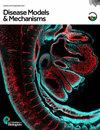在小脑肌张力障碍小鼠模型中,纹状体旁白质中间神经元而非胆碱能中间神经元被激活。
IF 3.3
3区 医学
Q2 CELL BIOLOGY
引用次数: 0
摘要
肌张力障碍应该是由基底神经节运动环路的异常引起的;然而,关于小脑是否参与其中一直存在争论。我们采用已建立的小脑性肌张力障碍小鼠模型,通过注射欧巴马因来研究小脑的贡献。首先,我们研究了小脑内侧核(EPN)、黑质网状旁(SNr)、苍白球外侧(GPe)和纹状体神经元是否在模型中被激活。接下来,我们研究了多巴胺D1受体激动剂(D1激动剂)和多巴胺D2受体拮抗剂(D2拮抗剂)或选择性消融纹状体旁神经元(PV)是否能调节它们的不自主运动。与对照组小鼠相比,小脑肌张力障碍小鼠的EPN、SNr和GPe中c-fos阳性细胞数量更多,纹状体PV中间神经元中c-fos的阳性比率也更高。此外,全身注射D1激动剂和D2拮抗剂以及选择性消融纹状体PV中间神经元可缓解小鼠的不自主运动。基底节运动环路的异常可能是小脑肌张力障碍的关键所在,而调节PV中间神经元可能是一种新的治疗策略。本文章由计算机程序翻译,如有差异,请以英文原文为准。
Striatal parvalbumin interneurons, not cholinergic interneurons, are activated in a mouse model of cerebellar dystonia.
Dystonia is supposed to arise from abnormalities in the motor loop of the basal ganglia; however, there is an ongoing debate regarding cerebellar involvement. We adopted the established cerebellar dystonia mice model by injecting ouabain to examine the contribution of the cerebellum. Initially, we examined whether the entopeduncular nucleus (EPN), substantia nigra pars reticulata (SNr), globus pallidus externus (GPe), and striatal neurons were activated in the model. Next, we examined whether dopamine D1 receptor agonists (D1 agonist) and dopamine D2 receptor antagonists (D2 antagonist) or selective ablation of striatal parvalbumin (PV) interneurons could modulate their involuntary movements. The cerebellar dystonia mice had a higher number of c-fos-positive cells in the EPN, SNr, and GPe, as well as a higher positive ratio of c-fos in striatal PV interneurons than the control mice. Furthermore, systemic administration of combined D1 agonist and D2 antagonist and selective ablation of striatal PV interneurons relieved their involuntary movements. Abnormalities in the motor loop of the basal ganglia could be crucially involved in cerebellar dystonia, and modulating PV interneurons might provide a novel treatment strategy.
求助全文
通过发布文献求助,成功后即可免费获取论文全文。
去求助
来源期刊

Disease Models & Mechanisms
医学-病理学
CiteScore
6.60
自引率
7.00%
发文量
203
审稿时长
6-12 weeks
期刊介绍:
Disease Models & Mechanisms (DMM) is an online Open Access journal focusing on the use of model systems to better understand, diagnose and treat human disease.
 求助内容:
求助内容: 应助结果提醒方式:
应助结果提醒方式:


